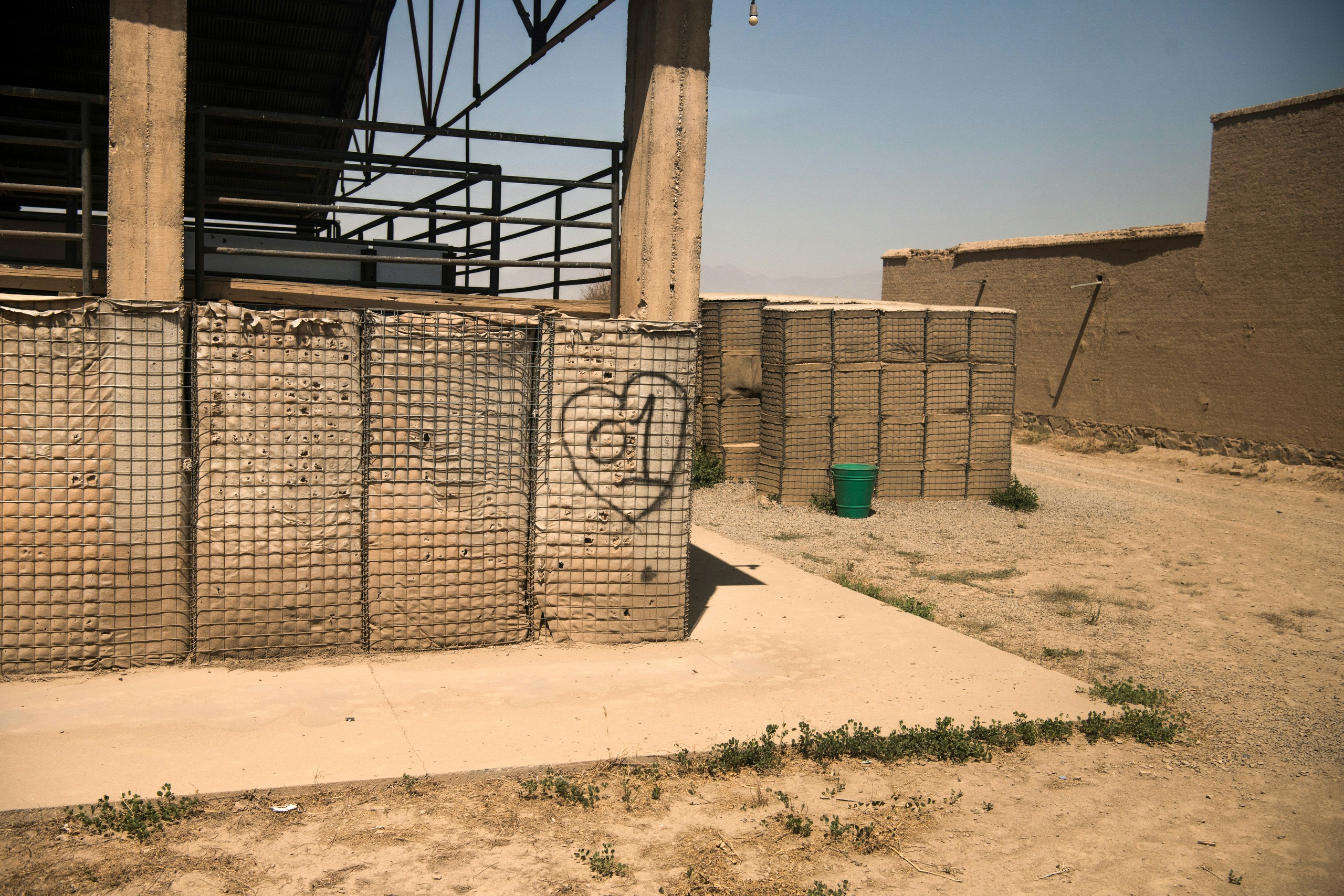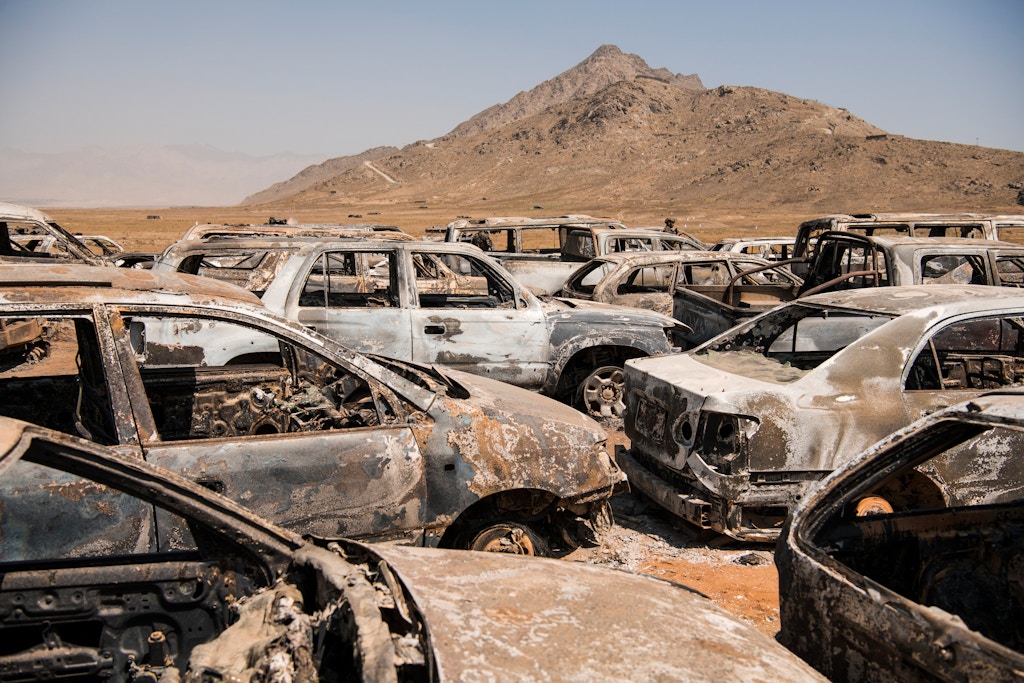Before the Taliban took control of Kabul in August, the U.S.-backed Afghan commandos known as Zero units were the ghosts of the Afghan battlefield. Along with their CIA advisers, they were feared and, in recent years, virtually invisible.
But in the hectic, violent weeks between the Taliban victory and the U.S. military withdrawal, fighters belonging to a Zero unit known as 01 — and other linked militias known collectively as National Strike Units, or NSUs — helped the Americans secure Hamid Karzai International Airport. Firing warning shots day and night, 01 fighters sought to corral and search crowds of Afghans and foreigners trying to enter the airport to board evacuation flights, much as Taliban fighters struggled to maintain control at other airport entrances around the same time.
One evening in late August, an Afghan 01 commander whose fighters were guarding the airport’s northwestern gate asked an Intercept journalist taking photographs to identify himself to the fighter’s American handler. The handler, who was wearing a baseball cap and had a pistol strapped to his waist, suggested that if the journalist wanted to leave on an evacuation flight, he should do so immediately. Soon, the man said, he’d be evacuating “my guys,” referring to the 01 fighters. After that, the gate would be closed for good. The American then turned to the 01 commander and explained the value placed on a free press by citizens of the country to which he and his fighters would soon be flown.
The CIA prioritized the evacuation of Zero unit members from Afghanistan, flying out as many as 7,000 of the former commandos and their relatives even as thousands of vulnerable former U.S. government and military employees, human rights activists, and aid workers were left behind. NSU commandos refused to allow a former U.S. government interpreter through the airport gates unless she gave them $5,000 each for herself, her husband, and their three children, Al Jazeera reported. The woman, who said she and her relatives were beaten by NSU members at the airport, could not afford the bribe. Two former members of a different U.S.-trained military unit, the Afghan National Army’s KKA, or Afghan Special Unit, told The Intercept from a safe house in Kabul that no formal effort was made to evacuate them and that unit members who were able to board flights did so through personal connections. The two former members themselves had been turned away by 01 militiamen after approaching the airport’s northwestern gate. Since then, they said, at least four KKA members have been tracked down by Taliban fighters and killed.
The CIA’s ability to evacuate its allies appears to have far outstripped that of other U.S. government entities and signals its pivotal role in the war. The agency evacuated as many as 20,000 Afghan “partners” and their relatives, the Washington Post reported, nearly one-third of the 60,000 Afghans the U.S. has taken in overall. The CIA did not respond to a request for comment.
Most coverage of the CIA’s efforts has been laudatory. But the Zero units were known for deadly night raids that killed an untold number of civilians across Afghanistan. The Intercept documented 10 raids conducted by 01 in Wardak Province, southwest of Kabul, in which at least 51 civilians, including children, were killed — many at close range, in execution-style assaults. Most 01 missions were led by a small number of CIA “advisers,” as their Afghan fighters knew them, or U.S. special forces borrowed from the Pentagon’s Joint Special Operations Command.
“The U.S. should not be offering safe haven to those who committed war crimes or serious human rights abuses,” said Patricia Gossman, associate director for the Asia division at Human Rights Watch, who wrote a report on the units’ abuses. “In Afghanistan, these forces were never held accountable for their actions, which included summary executions and other abuses. The U.S. and any other countries resettling members of these units should screen arrivals and investigate any for their possible involvement in human rights violations.”
Most of the Zero unit members were flown to Qatar, where CIA paramilitary officers worked to get their former Afghan colleagues sent to the U.S., according to a former senior U.S. intelligence official with direct knowledge of the operation. The former Afghan commandos are being housed on U.S. military bases, including two in Virginia and New Jersey, and at Ramstein Air Base in Germany while they await resettlement, according to the former senior U.S. official, two former senior Afghan intelligence officials, and a former commando from a different Afghan unit who was evacuated to the same U.S. base as some Zero unit members. Another small group of Zero unit members is in the United Arab Emirates, but they are expected to come to the U.S. within weeks, one of the former Afghan officials told The Intercept. Both former Afghan officials said they have spoken with relatives who previously belonged to the Zero units and are now in the United States.
Once known within the U.S. government as the Mohawks, Zero units started as an irregular commando force controlled by the CIA. The intelligence agency trained the teams to serve as guerrilla fighters out of small U.S. outposts, mainly in the north and east of the country, near the Pakistan border. Much of the original purpose of the program was to enable the CIA to conduct cross-border raids into Pakistan, a politically fraught and rarely approved activity for U.S. personnel.
The Zero units allowed the U.S. to conduct deniable operations and avoid accountability and were similar in some respects to the CIA’s Phoenix program during the Vietnam War. For that program, the agency created Provincial Reconnaissance Units comprised mostly of South Vietnamese guerrillas led by American commanders. Like the Afghan Zero units, the PRUs gathered intelligence and assassinated suspected Viet Cong.
In 2010, the Afghan government signed an agreement with the CIA to turn the NSUs into a joint program with Afghanistan’s former intelligence service, the National Directorate of Security, or NDS, according to the two former senior Afghan officials, who were involved in the arrangement. While the missions would be jointly run, the units continued to be funded exclusively by the U.S. government, the two former Afghan officials told The Intercept. The change allowed the CIA to claim plausible deniability against accusations of human rights abuses or war crimes.
But in 2019, Afghanistan’s most senior defense official, then-Afghan national security adviser Hamdullah Mohib, told The Intercept that 01 was controlled by the CIA. “Quite frankly, I’m not fully aware … of how they work,” he said at the time. “We’ve asked for clarification on how these operations happen, who are involved, what are the structures of this. When they were set up, why are they not in Afghan control?”
Just after President Joe Biden took office in January, the CIA gave the NDS one year’s budget and said the agency would no longer support Zero units or continue funding them, one of the former Afghan intelligence officials told The Intercept.

Photo: Andrew Quilty
Eagle Base, the sprawling CIA and 01 compound on a hillside northeast of Kabul, used to be off-limits to all but America’s closest allies.
From the highway, passersby could see a shooting range cut into the side of the hill and a narrow road snaking up to a cluster of beige structures. Less visible was the complex of helicopter hangars, ammunition depots, and barracks as well as the former CIA black site known as the Salt Pit, where interrogations and torture were carried out in the earliest years of the war.
Perimeter security was extreme, even by Afghanistan’s standards. A ditch ringed an earthen wall 6 feet high. Next came concertina wire, faded red bollards linked by steel cables, and a 10-foot mud and concrete wall topped with more concertina wire, with elevated guard posts every 300 feet. Floodlights illuminated the entire circumference at night.
Before 2019, 01 fighters left Eagle Base in vehicle convoys for nighttime missions. That changed when convoys on two Wardak missions were ambushed, according to a former NDS counterterrorism officer who used to accompany 01 on raids in the province. Thereafter, almost all 01 missions were flown into Wardak aboard American Chinook helicopters. Residents living near Eagle Base told The Intercept in 2019 that they heard the distinct thwap of the dual-rotor helicopters several times a week, departing early in the evening and returning before dawn. Otherwise, 01 fighters were rarely seen.
But the Taliban knew who occupied Eagle Base. On July 25, 2019, a suicide car bomb targeted CIA officers traveling in unmarked Toyota Land Cruisers arriving at the gate, Taliban spokesperson Zabihullah Mujahid said in an interview that year. Local residents confirmed that a bombing took place against white Land Cruisers at the compound gate that day. The incident attracted little media attention. A spokesperson from Resolute Support, the now-defunct U.S. military mission in Afghanistan, told The Intercept that he was unaware of any foreign military casualties in Kabul that day. The CIA declined to comment.

Scores of burned-out civilian and military vehicles are seen within the CIA’s Eagle Base on Sept. 6, 2021. An ammunition depot, an armory, and several other structures were also destroyed by explosives and fire before the U.S. departure.
Photo: Andrew Quilty
Taliban fighters have occupied the expansive facility since parts of it were destroyed by fire and explosives in the final days of the American military withdrawal from Afghanistan at the end of August. In early September, a week after the last U.S. military aircraft had departed Kabul, Taliban fighters clad in a darker version of fatigues with the same tiger-stripe pattern worn by 01 escorted journalists through the ruins of Eagle Base, leading them through areas they said had been cleared of land mines and booby traps left by the Americans and their Afghan partners.
The fighters were from the Taliban’s “Badr” 313 Brigade, an elite commando unit named for the Battle of Badr 1,400 years ago, when the Prophet Mohammad is said to have overcome enemy forces with just 313 men. They were led by an English-speaking Taliban member in his 40s wearing traditional clothes, sunglasses, and a surgical mask.
Nearly two weeks earlier, at dusk on August 26, a suicide attack at the airport and subsequent gunfire had killed about 170, including 13 U.S. service members. Kabul residents were on edge. When another huge explosion was heard across the city before midnight, many feared that there had been a second deadly attack. But that explosion was a controlled detonation, one of several that destroyed ammunition depots, armories, and vehicles as well as various facilities inside Eagle Base that the CIA didn’t want to leave for the Taliban once the agency finally abandoned it. Brian Castner, Amnesty International’s senior crisis adviser for arms and military operations and a former U.S. Air Force explosive ordnance disposal officer, said The Intercept’s photos from the site suggested “a very hasty and messy withdrawal.”
Constellations of bullets, mortars, and grenades littered the charred foundations of ammunition depots destroyed by fire. In the burned-out shell of what appeared to be an armory, the barrels of Kalashnikovs, belt-fed PKM and DShK machine guns, rocket-propelled grenade launchers, and mortar tubes lay in piles like pick-up sticks.
Inside a dormitory building, the Zero units’ trademark tiger-stripe uniforms hung from hooks and littered the floor. In a steel locker, amid the discarded packaging of tactical gadgets and passport photos of a young family, a military patch in the shape of a pentagon read “The Shield & Swords of Afg, NSU (01).”
This content originally appeared on The Intercept and was authored by Andrew Quilty.
Andrew Quilty | Radio Free (2021-10-06T00:27:57+00:00) The CIA’s Afghan Proxies, Accused of War Crimes, Will Get a Fresh Start in the U.S.. Retrieved from https://www.radiofree.org/2021/10/06/the-cias-afghan-proxies-accused-of-war-crimes-will-get-a-fresh-start-in-the-u-s/
Please log in to upload a file.
There are no updates yet.
Click the Upload button above to add an update.
